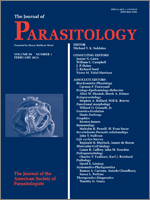Unexplained and episodic die-offs of the dwarf surf clam, Mulinia lateralis, have been reported on the West Atlantic coast, with such an occurrence in South Carolina in June 2010. A sample of live clams from the 2010 South Carolina event was collected, and 200 clams were measured and necropsied. Two species of tapeworm larvae were observed. Plerocercoids (Duplicibothrium sp.) occupied the digestive gland ducts, and merocercoids (Rhodobothrium sp.) were found beneath the mantle. Specimens of both species were sequenced to obtain partial 28S rRNA gene sequences, and they were identified as the tetraphyllidean D. minutum and the rhinebothriidean R. paucitesticulare, based on an NCBI Standard Nucleotide BLAST search. Of the 200 clams, 2.1% were infected with merocercoids (mean intensity 1.3 ± 0.2) and 75% with plerocercoids (mean intensity 4.3 ± 3.7). Intensity of infection by plerocercoids increased significantly with individual shell length. The presence of plerocercoids was associated with enlargement of the digestive gland ducts, but no other pathology was observed. Because uninfected clams were abundant among the stranded molluscs, these parasites are not considered to be the causative agent of the die-off. This is a new host record for both elasmobranch tapeworms.
How to translate text using browser tools
1 February 2013
Mulinia lateralis (Mollusca: Bivalvia) Die-Off in South Carolina: Discovery of a Vector for Two Elasmobranch Cestode Species
Isaure de Buron,
Patricia B. Roth,
Derk C. Bergquist,
David M. Knott
ACCESS THE FULL ARTICLE

Journal of Parasitology
Vol. 99 • No. 1
February 2013
Vol. 99 • No. 1
February 2013




